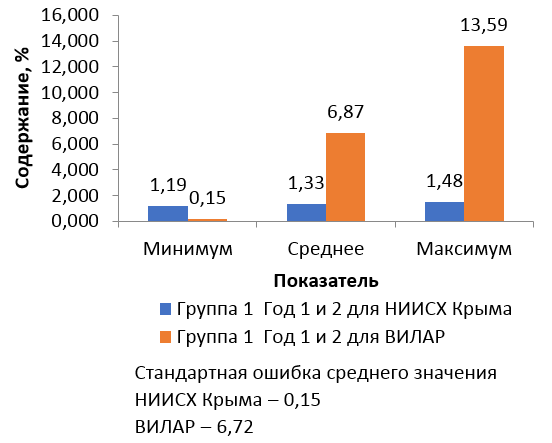STUDY OF THE COMPOSITION OF FREE FATTY ACIDS IN THE FRUIT OF NEPETA CATARIA L. FROM THE NON-BLACK SOIL ZONE AND THE CRIMEA
UDC 547.915:58.2
Abstract
Nepetae catariae herba is valuable medicinal raw material. It is get from a cultivated plant. Essential oil from Nepetae catariae herba is used. The fruits are attracting interest as a promising raw material remaining after the unused seed insurance fund. Along with the Nepetae herba, essential oil is used. The fruits remaining after the unused seed insurance fund are attracting interest as a promising source of biologically active substances. Fruits contain a lipid complex, which is not sufficiently studied. The aim is to study the content and composition of fatty acids in the lipid complex of catnip fruits from two regions of the Russian Federation: Non-chernozem belt and the Republic of Crimea. To study the correlation between fatty acid accumulation and meteorological factors too. The lipid complex of the fruits extracted with n-hexane in the Soxlet apparatus. Fatty acids composition was determined after methylation by gas-liquid chromatography with mass spectrometry detection method. 15 constituents were found. The content of the lipid complex averaged: from fruits obtained in the Non-chernozem belt, 26.06±1.3%; from the fruits obtained in the Crimea, 38.01±0.7%. Saturated fatty acids were very diverse. Pentadecanoic acid was common to all samples. Tridesaturated fatty acids were represented in both regions by α-linolenic acid. It is the dominant compound in all samples. We revealed the correlations between the content of fatty acids in the lipid complex in both regions and meteorological indicators. Erems of catnip are a valuable source of ω-3-unsaturated fatty acids.
Downloads
Metrics
References
The World Flora Online URL: http://www.worldfloraonline.org/search?query=Lamiaceae&limit=24&start=0&sort=.
Kilic Ö.A Iğdır University Journal of the Institute of Science and Technology, 2013, vol. 3, no. 4, pp. 21–25.
Safaei-Ghomi J., Djafari-Bidgoli Z., Batooli H. Chemistry of Natural Compaunds, 2009, vol. 45, pp. 913–915. DOI: 10.1007/s10600-010-9470-3.
Amirmohammadi F.Z., Azizi M., Nemati S.H., Iriti M., Vitalini S. Zeitschrift für Naturforschung. C, 2020, vol. 75 (7–8), pp. 247–254. DOI: 10.1515/znc-2019-0206.
Ashrafi B., Ramak P., Ezatpour B., Talei R.G. Journal of Research in Pharmacy, 2019, vol. 23(2), pp. 336–343. DOI: 10.12991/jrp.2019.141.
Baranauskienė R., Bendžiuvienė V., Ragažinskienė O., Venskutonis P.R. Food and Chemical Toxicology, 2019, vol. 129, pp. 269–280. DOI: 10.1016/j.fct.2019.04.039.
Hemaia M.M., Ibrahim F., Mohamed E.I., Ebtissam A.M., Hanan F.A. JPRIF, 2015, vol. 8, no. 10, pp. 10–17.
Akpinar N., Akpinar M.A., Gorgun S., Dirmenci T., Aktumsek A. Chemistry of Natural Compounds, 2008, vol. 44, no. 1, pp. 90–92.
Kilic T., Dirmenci T., Goren A.C. Natural Product Research, 2007, vol. 21, no. 5, pp. 465–468.
Hanan F.A., Ebtissam A.M., Mohamed E.I., Hemaia M.M., Faten M.I. Journal of American Science, 2010, no. 6, pp. 436–455.
Brouver V., Shtelin A. Spravochnik po semenovedeniyu sel'skokhozyaystvennykh, lesnykh i dekorativnykh kul'tur: per. s nem. [Handbook of seed science of agricultural, forestry and ornamental crops: translated from German]. Frankfurt am Main, 2010, 621 p. (in Russ.).
Budantsev A.L., Lobova T.A. Edinburg journal of Botany, 1997, vol. 54, no. 2, pp. 183–216.
Panekina T.V., Gusakova S.D., Umarov A.U. Chemistry of Natural Compounds, 1978, no. 14, pp. 139–141. DOI: 10.1007/BF0113461.
Hyo-Sun S., Sung-Whan K. Journal of the American Oil Chemists’ Society, 1994, vol. 71, pp. 619–622.
Wen-yi G., Yin-qing L., Gui-bin T. Chinese Journal of Experimental Tradicional Medical Formulae, 2010, no. 6, pp. 20−25.
Li T., Ming Z., Shen Y., Lv. G., Sun X. Advanced Materials Research, 2013, vol. 790, pp. 539−541.
Fes'kova Ye.V., Leont'yev V.N., Titok V.V., Anoshenko B.Yu. Biologicheskiye resursy, 2022, no. 1, pp. 105–109. (in Russ.).
Pogoda i klimat [Weather and climate]. URL: http://www.pogodaiklimat.ru. (in Russ).
Nu i pogoda [Well, the weather]. URL: https://nuipogoda.ru/. (in Russ).
Porokhovinova Ye.A., Shelenga T.V., Kosykh L.A., Sanin A.A., Kazarina A.V., Kutuzova S.N., Pavlov A.V., Brach N.B. Ekologicheskaya genetika, 2016, vol. 14, no. 1, pp. 13–26. DOI: 10.17816/ecogen14113-26. (in Russ.).
Berezhnaya G.A. Maslichnyye kul'tury, 2018, no. 4 (176), pp. 90–95. (in Russ.).
Kurkin V.A., Rosikhin D.V., Ryazanova T.K. Farmatsiya, 2017, vol. 66, no. 6, pp. 25–29. (in Russ.).
Brovko O.S., Zhil'tsov D.V., Ivakhnov A.D., Bogdanov M.V. Khimiya Rastitel'nogo Syr'ya, 2020, no. 1, pp. 57–66. DOI: 10.14258/jcprm.2020015500. (in Russ.).
Kopyt'ko Ya.F. Mezhdunarodnyy zhurnal prikladnykh i fundamental'nykh issledovaniy, 2021, no. 12, pp. 76–81. (in Russ.).

Copyright (c) 2023 chemistry of plant raw material

This work is licensed under a Creative Commons Attribution 4.0 International License.

This work is licensed under a Creative Commons Attribution 4.0 International License.
The authors, which are published in this journal, agree to the following conditions:
1. Authors retain the copyright to the work and transfer to the journal the right of the first publication along with the work, at the same time licensing it under the terms of the Creative Commons Attribution License, which allows others to distribute this work with the obligatory indication of the authorship of this work and a link to the original publication in this journal .
2. The authors retain the right to enter into separate, additional contractual agreements for the non-exclusive distribution of the version of the work published by this journal (for example, to place it in the university depository or to publish it in a book), with reference to the original publication in this journal.
3. Authors are allowed to post their work on the Internet (for example, in a university repository or on their personal website) before and during the review process of this journal, as this may lead to a productive discussion, as well as more links to this published work.











